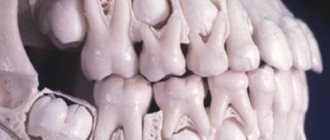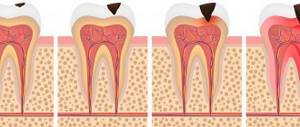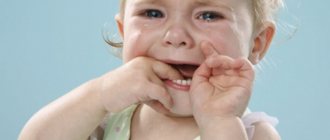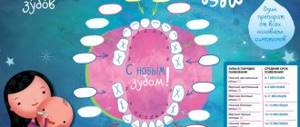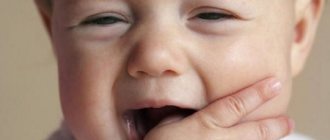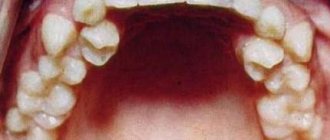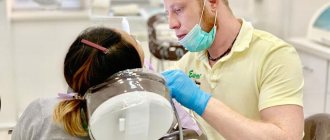The first year of a child's life is filled with so many important and exciting events that when he gets his first tooth, you may only be able to quietly rejoice that it happened. There is no need to worry if your baby's first tooth erupts later than his peers. The teething process can take many months. It is helpful for parents to know the order in which baby teeth typically appear, what problems arise, and what solutions the dentist can offer.
Timing of baby teeth eruption
Most young parents are aware that the four front teeth on the lower and upper jaw appear earlier than others. They also generally know that baby teeth take about three years to emerge. All other aspects of this process raise many questions and become a cause for concern.
As dentists explain, the eruption of baby teeth begins with the central incisors of the lower jaw. With the exception of the first molars, which may appear even before the frontal teeth, the remaining teeth erupt in an order that can be described as “from anterior to posterior.” Typically, teething occurs in the following sequence:
- 6-10 months. Two front teeth (central incisors) of the lower jaw
- 8-12 months. Two front teeth (central incisors) of the upper jaw
- 9-13 months. The lateral incisors of the upper jaw, that is, the teeth located next to the central incisors
- 10-16 months. Lateral incisors of the mandible
- 13-19 months. First molars of the upper jaw (space for canines is still empty)
- 14-18 months. Mandibular first molars
- 16-22 months. Maxillary canines located just behind the lateral incisors
- 17-23 months. Canines of the lower jaw
- 23-31 months. Mandibular second molars, located immediately behind the first molars
- 25-33 months. Maxillary second molars
The order of eruption of baby teeth
Baby teeth appear in pairs, almost simultaneously, on the child's upper and lower jaws, although some teeth may erupt slightly earlier than others. The eruption schedule for baby teeth is quite flexible, so, for example, your baby's first molars and canines may appear at the same time. It is completely normal for teething to begin before your baby is six months old. You will definitely notice changes in your baby's behavior: he will begin to chew toys to scratch his gums, and he will salivate more abundantly. These signs can appear as early as four months of age, say experts from the dental portal Stoma.Guru. You also don't have to worry if the first tooth appears closer to the time your baby is 10 months old.
The timing of teething is largely determined by heredity, but in girls this process can occur a little faster than in boys. In addition, baby teeth can erupt straight or at an angle and subsequently straighten out.
Teething in infants
It can be said without much exaggeration that teething in babies is one of the most worrying problems for their parents, many of whom peer anxiously at the baby’s gums long before the first symptoms appear. After a period of colic, this is a truly serious test for the family, which, however, can pass unnoticed and painlessly. However, in most cases, the eruption of baby teeth causes severe discomfort for the baby and his parents, so you should carefully understand all the features of this process.
Formation of tooth buds
In fact, teething is the logical result of a process that begins in the prenatal development of the child. The rudiments of teeth are formed at 6-7 weeks of pregnancy. Some diseases suffered by the expectant mother, toxicosis, conflict of Rh factors, as well as taking medications can negatively affect the condition of the baby’s teeth. Thus, various anomalies of the dental system appear as early as 16 weeks of pregnancy. Note that by the time the child is born, the crowns of the teeth are usually fully formed. In total, in two jaws there are 20 rudiments of milk teeth and 16 rudiments of permanent teeth.
Timing of eruption
It is believed that a baby's first teeth appear at the age of 6-8 months. However, we note that these are average data, and in reality the first tooth can erupt at either 4 or 10 months. Moreover, there have been cases where a child was born with teeth already emerging, as well as cases where the first tooth appeared only after the first year of life. Thus, the time of teething in each case is strictly individual and depends on the characteristics of the child’s development, the nutritional system, and the nature of the pregnancy. As a rule, the complete eruption of all twenty primary teeth is completed when the child reaches the age of three years. The table below shows the average time for baby teeth to erupt in children.
Baby teeth eruption system
Speaking about the timing of teething in children, we note the individual schedule of this process for each baby. As for the order of appearance of specific teeth, in this case we are talking about a more strict sequence. As a rule, teething is a paired process. That is, two teeth erupt at the same time. So, the two lower central incisors appear first, then the two upper ones. Of course, deviations from the norm are possible at this point as well. For example, four teeth can erupt at once, rather than two. In such cases, there is no need to worry, since nature has specific teething characteristics for each child, and humans cannot influence them.
Signs of teething in babies
Some happy parents learn about the appearance of a tooth in their child by seeing it directly in the child’s mouth, without screaming, crying or sleepless nights. Unfortunately, not everyone is so lucky, and most parents have to go through difficult trials. In order to erupt, the tooth must overcome the bone tissue and gum. Naturally, this causes severe pain in the child. However, the initial symptoms of this process may be subtle, and many mothers and fathers, at the slightest whim of the baby, wonder: maybe teeth? To make this difficult parental task easier, let’s look at the signs of teething in more detail.
- Swelling of the gums at the site of tooth eruption. The gums become inflamed and redness appears. The baby experiences severe itching, so he pulls all kinds of objects into his mouth, including his own fingers, to relieve his condition. Closer to the very moment of eruption, a whitish swelling becomes noticeable on the gum. In some cases, bluish hematomas appear at the site of eruption.
- During this period, salivation increases. Because of this, an irritated rash may appear on the baby's skin.
- The child's condition worsens. He becomes irritable, moody, and his mood changes dramatically. The baby's sleep is restless, he often wakes up at night.
- Some children's appetite worsens at this time. Although it is worth noting that the opposite cases are also possible, when the baby constantly reaches out to the mother’s breast to relieve the itching in the gums.
- Often during the period of teething, an increase in the child’s body temperature is observed. A normal temperature is considered to be between 37-37.5 degrees, although there is also a significant increase - up to 39 degrees. As a rule, this temperature lasts no more than two days.
- Often during this period the baby may develop a cough and runny nose. Teething itself is not their cause, but is associated with increased salivation. The baby cannot cope with a large amount of saliva, and it can accidentally get into the respiratory tract. In addition, during the period of teething, the baby’s immunity decreases, and he becomes susceptible to various colds. So a runny nose and cough can appear simply from an accompanying cold.
- Increased salivation can also cause diarrhea and vomiting in the baby. The occurrence of diarrhea is associated with changes in intestinal motility due to swallowed saliva. This phenomenon is not pronounced, occurs no more than 2-3 times a day and goes away after 2-3 days.
Note to parents!
It is necessary to distinguish the painful conditions of a child during teething from other diseases that arise independently of this.
- If the elevated body temperature lasts more than two days and is more than 39 degrees, you should consult a doctor.
- If you experience intense diarrhea, with bloody or watery discharge, you should also be wary. These symptoms may be a sign of an intestinal infection.
- Parents should be alert to a severe runny nose with greenish purulent discharge. If it lasts more than 3-4 days, this is a reason to seek medical help.
- If your baby's cough does not go away after a few days, becomes more intense and is accompanied by wheezing and phlegm, it may also be a symptom of a serious illness.
Helping your baby with teething
During this period, parents should be as attentive as possible to the child, surround him with care and affection. It should be remembered that he is capricious and crying not because of an empty whim, but because of severe pain, and the task of mom and dad is to alleviate his condition. What means do they have at their disposal?
- Various teethers or special toys for gums can be very effective means for improving the baby’s condition. By putting them in the mouth, the child thus massages the gums. When choosing, you should make sure that the objects do not have sharp edges and the baby cannot get hurt. Now there are teethers with liquid on sale; they can be easily cooled in the refrigerator and given to the child to chew. Cold has a very beneficial effect on your baby's gums. The main thing is not to overdo it with cooling the teether, because if it is too cold, it can cause a cold.
- Gum massage. It is known that during this period the child constantly puts his fingers and various objects into his mouth in order to relieve itching in the gums. You can help him with this with a simple massage. It is performed with your own clean finger using soft, careful movements. Another method involves light movements with your fingers from the wings of the nose to the corners of the mouth.
- To avoid irritating your baby's skin, you should constantly wipe saliva from his face with a soft cloth. Note that many pediatricians advise not to wipe it, but to blot it.
- Experts advise not to adhere to a strict feeding schedule during teething. Many children at this time require breastfeeding more often than always, and you should not refuse them this.
- To reduce pain, you can use special gels to facilitate teething. Such products contain light anesthetics suitable for children. It is recommended to use gels in case of severe painful conditions in the baby and no more than 3-4 times a day for no more than 3 days in a row.
Causes for concern
However, in some cases, irregular teething requires medical intervention. Firstly, children have so-called natal and neonatal teeth: if your child was born with teeth or they erupt in the first month of life, you should immediately consult a dentist. As experts explain, these teeth can be additional, or supernumerary, or complete, but erupted very early. They are distinguished by great mobility. If the dentist determines that the teeth are supernumerary, he or she may recommend removing them.
Also, a visit to the dentist may be necessary in case of congenital absence of teeth, or hypodontia. According to researchers from the Kazan State Medical Academy, the absence of incisors or first molars of the upper jaw is extremely rare; Heredity plays a significant role in the development of this deviation.
As soon as your baby's first teeth emerge, start using a special baby toothbrush with a small head and very soft bristles designed to gently but effectively clean baby teeth. Teach your child good oral care from an early age, and be sure to schedule a visit to the dentist between the eruption of the first tooth and your baby's first birthday.
But should the process of teething also be accompanied by a runny nose and nasal congestion?
No, such manifestations should not happen. And if nasal congestion is still present during teething, then first of all it is necessary to exclude the parallel development of a respiratory infection, as well as an allergic reaction, especially if you introduce complementary foods or new foods to the child, or if there is an increased number of respiratory allergens in the house, for example, the presence of domestic animals.
If there is neither one nor the other, then the vessels of the child’s nasal mucosa are really dilating and swelling appears due to such a provoking factor as teething, which should not normally be the case. Therefore, many otorhinolaryngologists are inclined to conclude that this is one of the signs of a child’s possible predisposition to vasomotor rhinitis. This vasomotor reaction usually goes away within 2-3 days after eruption.
